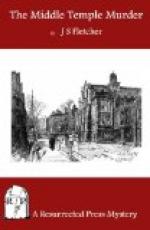“That’s so,” assented Rathbury. “Of course, the next thing’ll be to find out all about the Mr. Aylmore of twenty years since. When a man won’t tell you where he lived twenty years ago, what he was exactly doing, what his precise relationship with another man was—why, then, you’ve just got to find out, eh? Oh, some of our fellows are at work on the life history of Stephen Aylmore, Esq., M.P., already—you bet! Well, now, Spargo, here’s the famous box.”
The detective brought the old leather case out of the cupboard in which he had been searching, and placed it on his desk. Spargo threw back the lid and looked inside, measuring the inner capacity against the exterior lines.
“No false bottom in that, Rathbury,” he said. “There’s just the outer leather case, and the inner lining, of this old bed-hanging stuff, and that’s all. There’s no room for any false bottom or anything of that sort, d’you see?”
Rathbury also sized up the box’s capacity.
“Looks like it,” he said disappointedly. “Well, what about the lid, then? I remember there was an old box like this in my grandmother’s farmhouse, where I was reared—there was a pocket in the lid. Let’s see if there’s anything of the sort here?”
He threw the lid back and began to poke about the lining of it with the tips of his fingers, and presently he turned to his companion with a sharp exclamation.
“By George, Spargo!” he said. “I don’t know about any pocket, but there’s something under this lining. Feels like—here, you feel. There—and there.”
Spargo put a finger on the places indicated.
“Yes, that’s so,” he agreed. “Feels like two cards—a large and a small one. And the small one’s harder than the other. Better cut that lining out, Rathbury.”
“That,” remarked Rathbury, producing a pen-knife, “is just what I’m going to do. We’ll cut along this seam.”
He ripped the lining carefully open along the upper part of the lining of the lid, and looking into the pocket thus made, drew out two objects which he dropped on his blotting pad.
“A child’s photograph,” he said, glancing at one of them. “But what on earth is that?”
The object to which he pointed was a small, oblong piece of thin, much-worn silver, about the size of a railway ticket. On one side of it was what seemed to be a heraldic device or coat-of-arms, almost obliterated by rubbing; on the other, similarly worn down by friction, was the figure of a horse.
“That’s a curious object,” remarked Spargo, picking it up. “I never saw anything like that before. What can it be?”
“Don’t know—I never saw anything of the sort either,” said Rathbury. “Some old token, I should say. Now this photo. Ah—you see, the photographer’s name and address have been torn away or broken off—there’s nothing left but just two letters of what’s apparently been the name of the town—see. Er—that’s all there is. Portrait of a baby, eh?”




